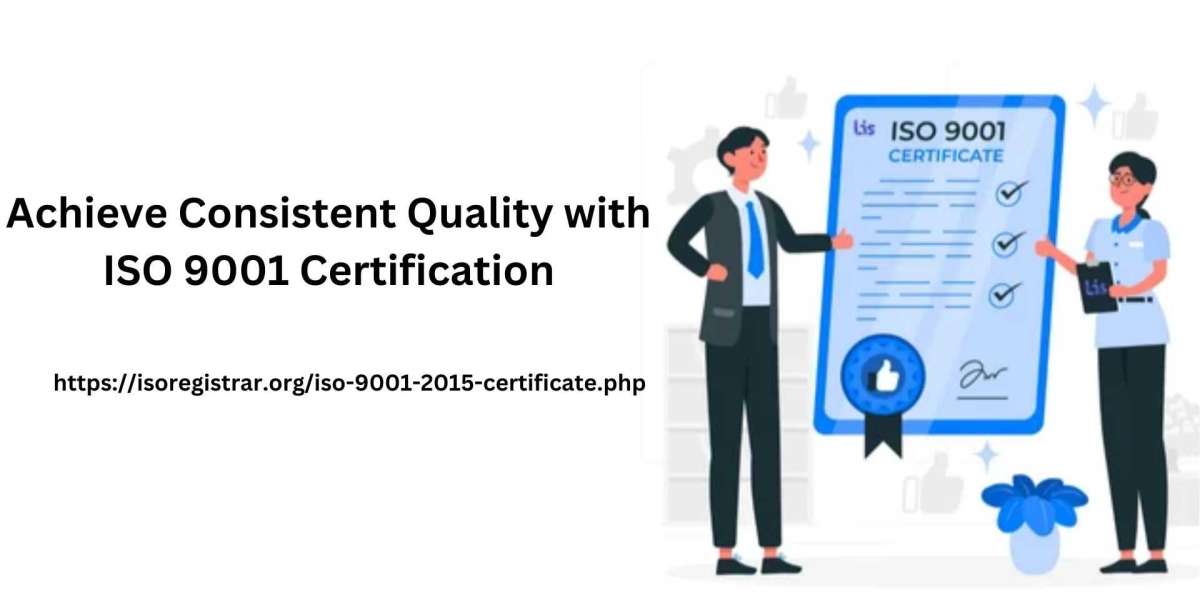Introduction
In today’s fast-paced business environment, maintaining consistent quality is essential for sustaining customer satisfaction and competitive advantage. ISO 9001 certification offers a proven framework for achieving and maintaining high-quality standards across various industries. This globally recognized standard provides organizations with the tools and processes necessary to ensure that their products and services consistently meet customer and regulatory requirements. This article explores how ISO 9001 certification helps businesses achieve consistent quality and the benefits of implementing this standard.
What is ISO 9001 Certification?
ISO 9001 is an international standard for quality management systems (QMS) developed by the International Organization for Standardization (ISO). The standard outlines a set of criteria for establishing, implementing, maintaining, and improving a QMS. ISO 9001 is designed to help organizations enhance their quality management processes, meet customer expectations, and comply with regulatory requirements.
Key Elements of ISO 9001:
- Customer Focus: Prioritizing and meeting customer needs and expectations.
- Leadership: Providing clear direction and support for quality management.
- Engagement of People: Involving employees in quality initiatives and fostering a culture of quality.
- Process Approach: Managing activities as interconnected processes to improve efficiency.
- Improvement: Continuously enhancing processes and systems.
- Evidence-Based Decision Making: Making informed decisions based on data and analysis.
- Relationship Management: Building and maintaining effective relationships with stakeholders.
Achieving Consistent Quality with ISO 9001
ISO 9001 certification provides a structured approach to quality management that helps organizations achieve consistent quality through several key practices:
1. Standardizing Processes
Consistency in quality begins with standardized processes. ISO 9001 requires organizations to document and standardize their processes, ensuring that every aspect of production or service delivery adheres to established procedures.
- Process Documentation: Documenting processes, procedures, and workflows helps in maintaining consistency and reduces variability.
- Standard Operating Procedures (SOPs): Implementing SOPs ensures that tasks are performed uniformly, leading to consistent outcomes.
2. Implementing Quality Controls
ISO 9001 emphasizes the importance of quality controls to monitor and manage the consistency of products and services.
- Quality Checks: Regular quality checks and inspections are essential to identify and address any deviations from established standards.
- Control Measures: Implementing control measures at various stages of production or service delivery helps in maintaining quality and preventing defects.
3. Fostering a Culture of Quality
Achieving consistent quality requires a culture where quality is prioritized at all levels of the organization. ISO 9001 promotes employee involvement and engagement in quality management.
- Training and Development: Providing training ensures that employees understand quality standards and their role in maintaining them.
- Employee Involvement: Encouraging employees to participate in quality initiatives and provide feedback helps in identifying areas for improvement and fostering a culture of quality.
4. Using Data and Metrics
Data-driven decision-making is a core principle of ISO 9001. By using data and performance metrics, organizations can monitor quality, identify trends, and make informed decisions to ensure consistency.
- Performance Metrics: Tracking key performance indicators (KPIs) helps in assessing the effectiveness of processes and identifying areas for improvement.
- Data Analysis: Analyzing data provides insights into quality performance and helps in making informed decisions to enhance consistency.
5. Conducting Regular Audits
Internal and external audits are critical for maintaining consistent quality. ISO 9001 requires organizations to conduct regular audits to assess the effectiveness of their QMS and ensure compliance with the standard.
- Internal Audits: Performing internal audits helps in identifying non-conformities, evaluating process effectiveness, and implementing corrective actions.
- External Audits: Engaging with a certification body for external audits verifies compliance with ISO 9001 and provides an objective assessment of quality management practices.
6. Embracing Continuous Improvement
Continuous improvement is a fundamental principle of ISO 9001. By regularly reviewing and improving processes, organizations can enhance consistency and adapt to changing needs.
- Corrective and Preventive Actions: Addressing issues through corrective and preventive actions helps in maintaining consistent quality and preventing recurrence.
- Feedback and Reviews: Collecting feedback from customers and conducting management reviews help in identifying opportunities for improvement and implementing necessary changes.
Benefits of ISO 9001 Certification
Implementing ISO 9001 certification offers several benefits that contribute to achieving and maintaining consistent quality:
- Enhanced Customer Satisfaction: By consistently meeting customer expectations and delivering high-quality products and services, organizations can improve customer satisfaction and loyalty.
- Improved Operational Efficiency: Standardized processes and quality controls lead to greater efficiency, reduced waste, and optimized resource utilization.
- Reduced Risk: Identifying and addressing potential issues through risk-based thinking helps in minimizing the likelihood of defects and inconsistencies.
- Increased Competitive Advantage: ISO 9001 certification serves as a mark of quality that can differentiate organizations in the marketplace and enhance their competitive position.
Note: Apply for iso 14001 certification through the iso portal
Conclusion
ISO 9001 certification provides a robust framework for achieving consistent quality in products and services. By standardizing processes, implementing quality controls, fostering a culture of quality, utilizing data, conducting regular audits, and embracing continuous improvement, organizations can ensure that they consistently meet customer and regulatory requirements. The benefits of ISO 9001 certification extend beyond quality assurance to include improved operational efficiency, reduced risk, and enhanced customer satisfaction. For organizations committed to maintaining high-quality standards and achieving long-term success, ISO 9001 certification is a valuable tool for driving excellence and consistency in their quality management practices.














